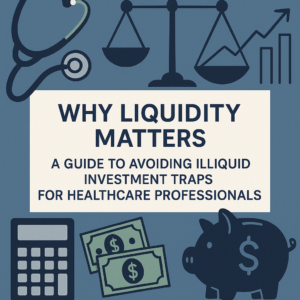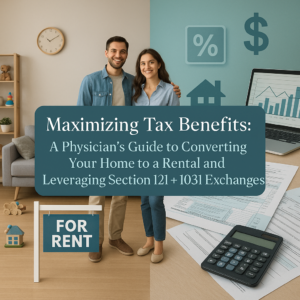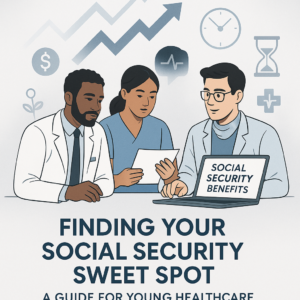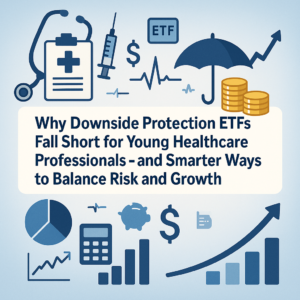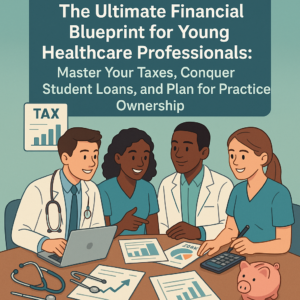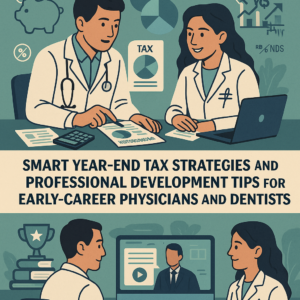Why Downside Protection ETFs Fall Short for Young Healthcare Professionals—and Smarter Ways to Balance Risk and Growth
Disclaimer: Past performance is not indicative of future results. Investing involves risk, including the possible loss of principal.
As a physician, dentist, or other healthcare professional beginning your career, building a robust investment portfolio is critical for your long-term financial health. The market offers a range of products promising “downside protection,” including a popular group of downside protection ETFs. These funds aim to cap losses in a downturn while still participating modestly in market gains. But do they truly deliver the protection and growth you need? In most cases, the answer is no.
In this in-depth guide, we’ll explore:
- How downside protection ETFs work
- Why they often underdeliver for young professionals
- Cost, complexity, and hidden drawbacks
- Traditional strategies that may serve you better
- Steps to build a balanced, growth-oriented portfolio
1. What Are Downside Protection ETFs?
Downside protection ETFs (also called “buffer ETFs” or “defined outcome ETFs”) use options and derivatives to create a floor under losses—typically at the expense of capping upside returns. In a given 12-month period, these funds may limit your loss to, say, 10%, while also capping your gain at 6% or 7%. The theory is appealing: reduce extreme losses without giving up all market participation.
Key features:
- Buffered downside loss in a defined period
- Capped upside return, usually around 6–7%
- Rolling annual windows or fixed terms
- Option-based strategies requiring active rollovers
However, data shows these caps bite hard: 58% of 12-month S&P 500 returns exceed 7%—meaning you miss out on the majority of positive years. And while 71% of rolling windows are positive, you sacrifice material upside for limited downside relief.
2. Why Young Healthcare Professionals Are Drawn to “Protected” ETFs
Physicians and dentists often carry substantial student debt, variable compensation, and delayed peak earning years. Naturally, the promise of “safeguarding” your first significant investments is tempting. You want:
- Peace of mind when markets swing wildly
- Preservation of capital for short-term goals (residency start, down payment)
- Exposure to equities for long-term growth
Downside protection ETFs market directly to risk-averse investors, touting simplicity and the allure of “set it and forget it” protection. But the reality is more nuanced—and often underwhelming.
3. The Hidden Costs and Complexities
3.1 Expense Ratios and Trading Costs
These ETFs typically charge higher expense ratios—often 0.50% to 1.00%—to cover option premiums and strategy fees. Compare that to broad market index ETFs at 0.03% to 0.10%. Over decades, those extra basis points compound to tens of thousands of dollars in eroded returns.
3.2 Timing and Rollover Risk
The protection works only if you hold from the designated start date to the end date. Buying “mid-cycle” means you pay for protection you can’t fully reap. Market moves between roll dates can leave you under-protected or over-paying for options that have already drifted.
3.3 Opportunity Cost of Capped Gains
In strong bull markets, your upside limit kicks in early. Historical data: 58% of rolling 12-month S&P periods exceed a 7% gain. By capping that, you sacrifice substantial compound growth—precisely what young investors need most.
4. Comparing to Traditional Risk Management Strategies
Rather than complex buffers, many advisors recommend straightforward diversification:
- Equities (U.S., international, small cap, sector tilts)
- Fixed income (Treasuries, investment-grade bonds, TIPS)
- Alternative assets (real estate, commodities, real-asset funds)
- Regular rebalancing to target allocations
Why these often outperform “protected” ETFs over time:
- Lower fees and transparent holdings
- No hidden timing requirements
- Consistent exposure to market gains
- Ability to tailor risk using bond ladders, duration management
5. Smarter Alternatives for Young Healthcare Professionals
5.1 Target-Risk Portfolios
A diversified mix of stocks and bonds matched to your risk tolerance. Rebalance annually to maintain your desired allocation. This simple approach has beaten many fancy structures over the long run.
5.2 Bond Ladders for Short-Term Goals
For dollars earmarked for a home down payment or expected tuition, build a series of short-to-medium-term bonds or CDs. You gain predictable income and principal return without equity volatility.
5.3 Tax-Efficient Retirement Accounts
Maximize your 401(k)/403(b), IRA, or Roth IRA to shelter growth from taxes. Equity-heavy allocations here compound faster when left to grow tax-free or tax-deferred.
5.4 Dollar-Cost Averaging and Automatic Investing
Consistent contributions smooth out volatility. You buy more shares when prices fall, fewer when they rise. Over decades, this disciplined habit can reduce risk without sacrificing growth.
6. Building Your Customized Plan
No two healthcare careers are identical. Your plan should reflect:
- Current debt levels and repayment schedules
- Short-term liquidity needs (residency, relocation, startup costs)
- Long-term goals (early retirement, practice buy-in, legacy planning)
- Risk tolerance and time horizon
At Mainstay Capital, our process begins with understanding your unique situation. From there, we craft a diversified strategy grounded in low-cost ETFs, bonds, and alternatives—no unnecessary complexity or hidden caps.
7. Step-by-Step Implementation
- Define your goals: short, medium, and long term.
- Assess your risk tolerance honestly.
- Choose low-cost broad market ETFs for equities.
- Build a bond ladder or select diversified bond funds.
- Consider alternative allocations (real assets, private markets) if suitable.
- Automate contributions and rebalance at predetermined intervals.
- Review annually or upon life changes (promotion, practice sale).
Need help? Learn more about our services and how we guide young healthcare professionals toward financial confidence.
8. Conclusion
Downside protection ETFs may sound appealing, but their capped upside, higher fees, and timing pitfalls often leave young investors worse off over the long run. For most physicians and dentists just starting out, simple diversification, bond ladders for short-term goals, and disciplined contributions provide more growth potential and fewer surprises.
Your financial future deserves more than a promise of limited loss and capped gain. It needs a clear plan, low costs, and a portfolio built around your goals. Discover how Mainstay Capital can help you chart the path toward lasting financial health—no complex buffers required.
Disclaimer: Investing involves risk, including possible loss of principal. Consult your advisor before making investment decisions. Past performance is not indicative of future results.

